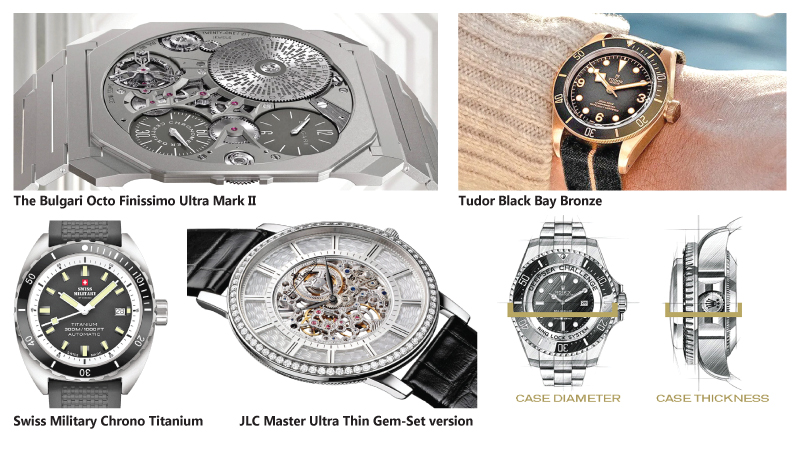 Case size? Lug to lug? Thickness? If you are confused by all the watch jargon out there (and this is only about watch measurements without thinking of other complications like flying tourbillon), here is a simple guide.
Case size? Lug to lug? Thickness? If you are confused by all the watch jargon out there (and this is only about watch measurements without thinking of other complications like flying tourbillon), here is a simple guide.
Watch measurements include the case diameter, thickness, lug width, and band width. These measurements are used to determine the size of a watch and how well it will fit on a person’s wrist.
Case diameter means the measurement across the watch dial from one side to the other, not including the crown(s). This typically ranges from 28–50 mm, though there are even bigger watches up to 56 mm.
A medium size watch is 32–41 mm in diameter, and a large watch is 42–47 mm or even up to 50 mm. In case you want to measure it yourself, the best bet is a caliper, though even a measuring tape will do.
The case thickness, on the other hand, affects how the watch feels on the wrist. A thinner case (6–8 mm) is more comfortable with a tight-fitting shirt or blouse and a thicker case (12 mm or more) is more casual and sporty. Generally digital watches such as Casio’s G-Shocks are on the heavy and thick side. Also, some watches with very complex mechanisms may be somewhat thick.
The thinnest
The Bulgari Octo Finissimo Ultra Mark II, is the thinnest watch in the world at a staggeringly thin 1.7mm. While the case and bracelet are made from sandblasted grade-5 titanium, the caseback is made from tungsten carbide, a particularly hard material which acts as the base plate for the BVL 180 caliber ticking away inside. The caliber this time is COSC certified, making the Ultra II not only the thinnest watch ever made, but also the thinnest chronometer certified watch ever made. If you have 600,000 euro burning a hole in your wallet, you can buy this watch.
Coming in at second place and released in mid 2022, is the RM UP-01 Ferrari which remains Richard Mille’s thinnest watch to date at 1.75mm. Jaeger-LeCoultre’s (JLC) skeleton watch Master Ultra-Thin Squelette is just 3.6 mm thick and costs just one tenth of the aforementioned Bulgari’s price. A gem set version of the same watch measures 4.73 mm thick. Closer home, India’s Titan also makes some really thin watches.
Lug width (lug to lug measurement) refers to the distance between the watch lugs. A watch lug is a thin metal extension on either side of a watch case that connects the watch to a strap or bracelet. They are also known as “horns”.
Watch lugs
Watch lugs act as a bridge between the watch case and the band. There are two types of lugs – Crab claw lugs that are shaped like crab claws, with gaps between the case and bracelet and cushion lugs which are shaped like a cushion, with rounded edges and a distinctive, pillow-like appearance.
Most men’s watches have a lug width of 18–22 mm. The lug width determines the width of a strap or bracelet. If you want to change the straps yourself at any time, you should know this measurement (some watches come with two straps in the box). Not that the lugs are generally not included in the case diameter measurement. Also, when measuring your wrist, leave some extra room for the lug.
Travel-friendly
Weight is another measurement, though watchmakers do not mention it all that much. The weight of a watch can vary widely, from 20 grams to over 160 grams, depending on the materials, size, and mechanics.
Watches made of lightweight materials like titanium, aluminum, or plastic are lighter, while watches made of stainless steel, solid gold, or ceramic are heavier. Larger watches tend to weigh more than smaller watches. The type of movements and complications used in a watch can affect its weight. Watch weight categories: Lightweight: 20–60 grams; Medium weight: 60–120 grams; Heavy weight: Over 120 grams.
Examples of watch weights: Seiko Diver Automatic SKX-007: 142 grams; Rolex GMT Master: 122 grams; Rolex Daytona: 132 grams; AP Royal Oak “Extra Thin” Caliber 2121: 112 grams; Omega Speedmaster Professional: 70 grams; NOMOS Glashütte Ahoi: 74 grams; Tudor (sister brand of Rolex) Ranger: 80 grams; Tudor Black Bay Bronze: 114 grams. Lightweight watches are comfortable to wear in most cases, travel-friendly and suitable for most wrist sizes.
On the other hand, they might be available only in limited material options and limited design choices.
Heavyweight watches are generally high quality timepieces that feature luxurious aesthetics with exceptional durability. They will hold a higher value and a higher resale value too. However, they might literally drag down your wrist and might not be comfortable to wear every day. Some individuals may prefer to wear heavier watches as they deliver a sense of luxury and robustness.
On the other hand, some may prefer to wear lightweight watches for a more comfortable experience. Therefore, the choice is purely based on personal preference. Note one more factor that affects watch weight – whether it is supported by a metal bracelet or a strap. Even a heavy watch with a leather strap will feel instantly lighter.
The most common purpose of buying a watch is to be able to wear it on a daily basis. If you are buying a watch purely for the purpose of investment or to be worn at special occasions only, then you do not have to work on everyday wearability.
However, if you are an avid watch enthusiast, you are more likely to wear and embrace your timepieces. Thus, it is important to ensure that you buy a watch that carries adequate weight to ensure the comfort of wear every day and throughout the day.
When buying a watch, it is important to take note of these combinations, as they will affect wearability in various ways. Ask the watch seller about the weight and dimensions and try on the watch at the showroom itself, because they can make bracelet/strap adjustments then and there. It is an extension of yourself, so give it some “time” to settle in.









